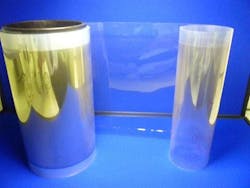Epigem secures nearly $600K to commercialize flexible OLEDs for EU Flex-o-Fab project
Redcar, England--Epigem has secured nearly $600,000 dollars to play a key role in delivering flexible organic light-emitting diode (OLED) lighting to commercial markets. Epigem is a member of the consortium that has committed around $15 million dollars including European Union (EU) funding to the Flex-o-Fab project to help bring flexible OLED lighting technology to market within six years.
Flex-o-Fab's project manager, Flora Li of the Netherlands' Holst Centre said, "This is an industry-led project that brings together companies and institutes with strong backgrounds in organic electronics from across Europe. They are all leaders in their respective fields whose knowledge and expertise complements each other perfectly—and we are keen to hear from other potential partners who can add to the mix."
Epigem's role is to produce the flexible OLED anode film based on its existing Epimesh product. Epimesh film has been developed as a flexible electrode (anode/cathode) with very low sheet resistance combined with high optical transparency.
The film is composed of an ultrafine metal mesh embedded into a polymer coating that is adhesively bonded onto one side of a flexible carrier film. Surface resistance is very low, typically in the range of 0.4 to 1.5 ohm/square, depending on the mesh pitch. Light transmission through the metal grid and polymer layers is typically more than 90%.
The newly launched Flex-o-Fab project will create a pilot-scale manufacturing chain for flexible OLEDs, and use it to develop reliable production processes. Funded through the EU’s 7th Framework Programme, the project team says it will strengthen Europe's leading position in the lighting industry by making flexible OLEDs a commercial reality, opening the doors for many new forms of lighting.
Tim Ryan, managing director of Epigem, said, "This is a fantastic opportunity to work with other leading technology companies and show what can be achieved by combining Europe-wide expertise, skills and experience. We will play a strong role in helping to deliver this exciting new lighting form to market. I'd like to thank the EU for its foresight in assessing the technology as ready for significant investment to bring to market. Success will create a new industry, potentially creating hundreds of jobs and generating millions for the economies of Europe."
SOURCE: Epigem; http://epigem.co.uk/latest-news/epigem-secures-e444k-funding-to-help-make-flexible-revolutionary-lighting-a-reality
About the Author

Gail Overton
Senior Editor (2004-2020)
Gail has more than 30 years of engineering, marketing, product management, and editorial experience in the photonics and optical communications industry. Before joining the staff at Laser Focus World in 2004, she held many product management and product marketing roles in the fiber-optics industry, most notably at Hughes (El Segundo, CA), GTE Labs (Waltham, MA), Corning (Corning, NY), Photon Kinetics (Beaverton, OR), and Newport Corporation (Irvine, CA). During her marketing career, Gail published articles in WDM Solutions and Sensors magazine and traveled internationally to conduct product and sales training. Gail received her BS degree in physics, with an emphasis in optics, from San Diego State University in San Diego, CA in May 1986.
